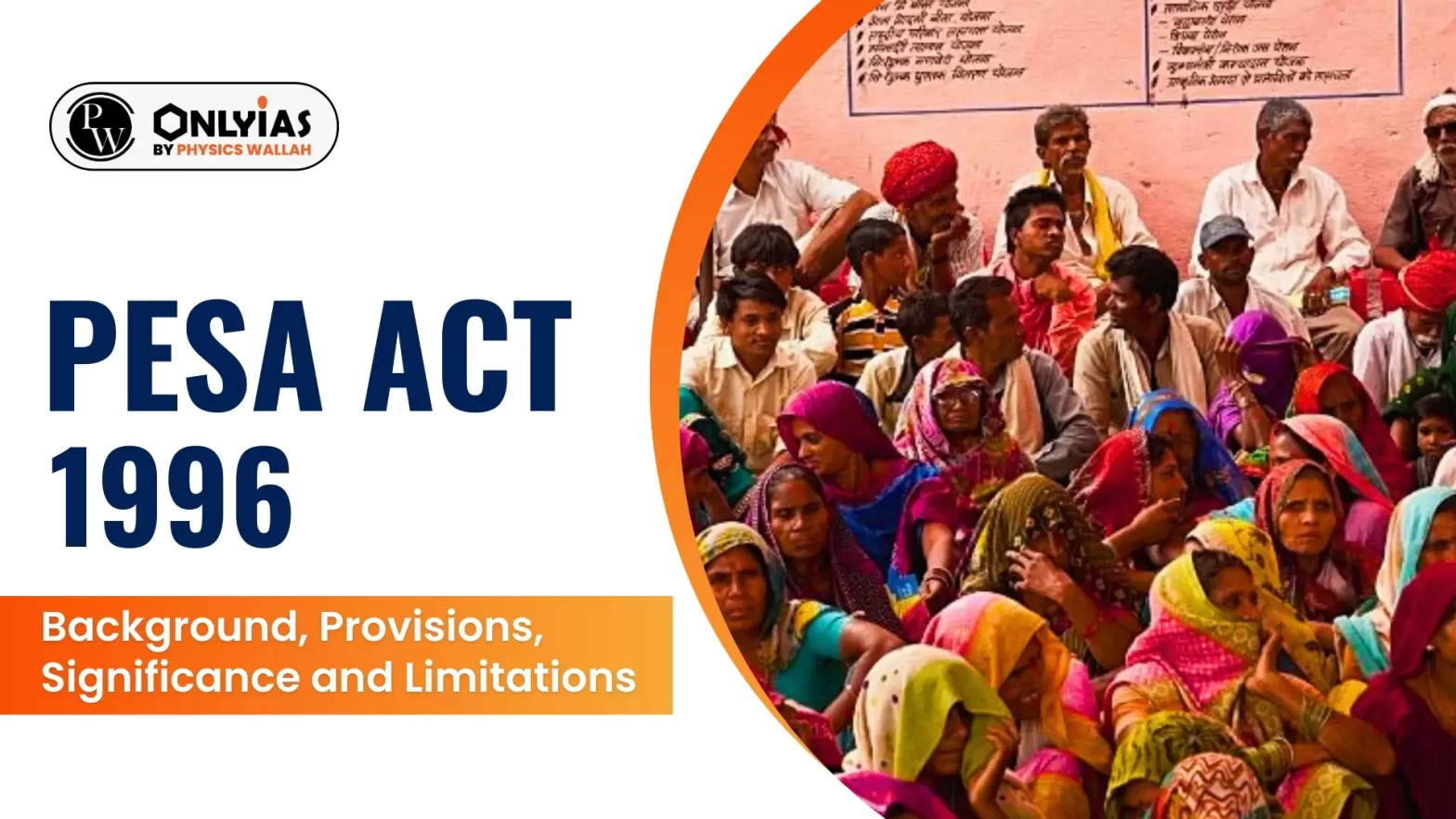PESA ACT 1996: Background, Provisions, Significance and Limitations

This editorial is based on the news “Secretary Shri Vivek Bharadwaj to inaugurate a Two-Day Regional Conference on the Strengthening of Panchayats Extension to Scheduled Areas Act on 4th – 5th March 2024 at Ranchi, Jharkhand” which was published in the PIB. Recently, a second two-day regional conference was held on strengthening of PESA at Ranchi, Jharkhand.
Powers and Functions Given to the Gram Sabhas:
- Right to mandatory consultation in land acquisition , resettlement and rehabilitation of displaced persons.
- Protection of traditional belief, the culture of the tribal communities
- Ownership of minor forest products
- Resolution of the local disputes
- Prevention of land alienation
- Management of village markets
- Right to control production, distillation, and prohibition of liquor
- Exercise of control over money-lending
- Any other rights involving the Scheduled Tribes
Background of PESA ACT 1996 (Panchayats Extension to Scheduled Areas Act)
- Applicability of the 73rd Constitutional Amendment: The 73rd constitutional amendment , 1992 was enacted to promote local self-governance in rural India. However, Its application to scheduled and tribal areas under Article 243(M) was restricted.
- Bhuria Committee Recommendation of 1995 : resulted in PESA Act 1996 for ensuring tribal self rule for people living in scheduled areas of India .
About PESA Act
- Pesa Full Form: The full form of PESA is Panchayats (Extension to Scheduled Areas) Act 1996 .
- Enacted On: 24 December 1996
- Aim: To extend the provisions of Part 9 of the Constitution to Schedule Areas , with certain exceptions and modifications.
- Nodal Ministry: Ministry of Panchayati Raj.
- States Under the PESA Act: Ten states under Fifth Schedule : Andhra Pradesh, Chhattisgarh, Gujarat, Himachal Pradesh, Jharkhand, Madhya Pradesh, Maharashtra, Odisha, Rajasthan, and Telangana.
Provisions of the PESA Act
- Align with Customary Law: A state legislature on the Panchayats in the Scheduled Areas shall align with the customary law, social and religious practices, and traditional management practices of community resources.
- Self-Governance Through Gram Sabha for people living in the Scheduled Areas
- Reservation in Panchayats: The reservation of seats in the Schedule Areas in every panchayat shall be in proportion to the population of the communities for whom reservation is sought to be given under Part 9 of the Constitution .
- However, the reservation for the Scheduled Tribesshall not be less than one-half of the total number of seats.
- Further, all seats of Chairpersons of Panchayats at all levels shall be reserved for the Scheduled Tribes.
Significance of the PESA Act
- Empowered Gram Sabhas: They play a key role in approving development plans and controlling all major developments in the social sectors.
- Tribal Integration: Decentralised governance helps in reducing the grievances of tribal people, building trust towards integration with mainstream .
- Protect Ecosystem: PESA empowers tribes through Gram Sabhas to preserve their connection with the ecosystem. E.g. In 2013, the Supreme Court of India ordered the Odisha Government to seek gram sabha permission for bauxite mining in Kalahandi and Rayagada district of Odisha, leading to cancellation of mining on Niyamgiri hills .
- Safeguard tribal interests and rights: The control over institutions and functionaries help in protecting their traditional culture, religion and identity as well as the rights provided by the Constitution.
Limitations of the PESA Act
- States Not Even Framed the Rules: Chhattisgarh, Jharkhand, Madhya Pradesh, and Odisha have not even framed the rules yet.
- Use of unfair means for bypassing the law: Acquisition of land happens under other acts, violating the spirit behind PESA, i.e. safeguard tribal land and consent of gram sabhas. In the Korba district of Chhattisgarh , the authorities decided to acquire land using the Coal Bearing Act of 1957.
- Poor Implementation of law: A 2010 study on “Status of PESA” in Andhra Pradesh, Gujarat, Chhattisgarh, Jharkhand, and Orissa by Indian Institute of Public Administration highlighted poor implementation of the Act. E.g., In Khunti district of Jharkhand, 65% of people whose land was acquired were not even asked about it.
- Lack of Clarity, Legal infirmity, bureaucratic apathy and lack of political will are some of the concerns.
Way Forward to the PESA ACT
- Implement Municipal Extension to Scheduled Areas (MESA) as per the Bhuria Committee recommendations.
- Capacity Building: Equipping Gram Sabhas with training and resources, adequate responsibilities to levy and collect taxes, fees, duties, or tolls.
- New Tribal Development Community Model: for tribal development.
- Convergence of PESA with other regulations: Like Forests Rights Act (2006) , Right to Fair Compensation and Transparency in Land Acquisition etc.
Consider the following statements:
1. The minimum age prescribed for any person to be a member of Panchayat is 25 years.
2. A Panchayat reconstituted after premature dessolution continues only for the remainder period.
Which of the statements given above is/are correct?
(d) Neither 1 nor 2
| Mains Question: The Panchayats Extension to the Scheduled Areas Act (PESA), 1996 was enacted with a view to conserving local traditions and cultural practices of the tribal people. In this context discuss the key features of the PESA Act and what are the challenges in its implementation? (250 words, 15 Marks) |


